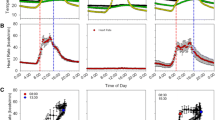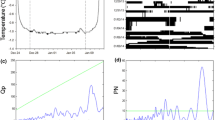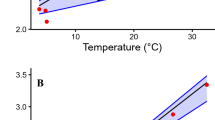Abstract
Nectarivorous whitebellied sunbirds, Nectarinia talatala, demonstrate distinct circadian patterns in osmoregulatory parameters. We recorded intake of a 1 mol/l sucrose solution which enabled calculation of total water gain, and collected cloacal fluid for measurements of volume, osmolality and aldosterone concentration. These variables were assessed hourly over 12 h of photophase, and averaged over the 12-h scotophase period. Overnight, when sunbirds were in negative water balance, aldosterone concentrations and outputs were significantly higher than diurnal levels, reflecting a shut-down of cloacal fluid production. Early morning was marked by a high rate of osmotic excretion, disproportionate to water gain or cloacal fluid output, followed by steady intake and cloacal fluid output during the morning and early afternoon. Reduced water flux (decreased feeding and cloacal fluid output) during mid-afternoon was accompanied by a paradoxical decline in osmotic excretion, whilst a significant increase in the discrepancy between water intake and output was recorded as the birds effectively stored water before the scotophase. These patterns of intake and excretion may be informative in explaining drinking and foraging behaviour in the field.




Similar content being viewed by others
Abbreviations
- ALDO :
-
aldosterone
- CF :
-
cloacal fluid
- GFR :
-
glomerular filtration rate
References
Arad Z, Arnason SS, Chadwick A, Skadhauge E (1985) Osmotic and hormonal responses to heat and dehydration in the fowl. J Comp Physiol B 155:227–234
Árnason SS, Rice GE, Chadwick A, Skadhauge E (1986) Plasma levels of arginine vasotocin, prolactin, aldosterone and corticosterone during prolonged dehydration in the domestic fowl; effect of dietary NaCl. J Comp Physiol B 156:383–397
Bartholomew G, Cade TJ (1963) The water economy of land birds. Auk 80:504–539
Boissin J, Nouguiér-Soule J, Assenmacher I (1969) Circannual and circadial rhythms of adrenal cortical function in birds. Indian J Zootomy 10:187–196
Breuner CW, Wingfield JC, Romero LM (1999) Diel rhythms of basal and stress-induced corticosterone in a wild, seasonal vertebrate, Gambel’s white-crowned sparrow. J Exp Zool 284:334–342
Calder WA, Calder LL, Fraizer TD (1990) The hummingbird’s restraint: a natural model for weight control. Experientia 46:999–1002
Collins BG (1981) Nectar intake and water balance for two species of Australian honeyeater, Lichmera indistincta and Acanthorhynchus superciliosis. Physiol Zool 54:1–13
Collins BG, Cary G, Packard G (1980) Metabolism, thermoregulation and evaporative water loss in two species of Australian nectar-feeding birds (family Meliphagidae). Comp Biochem Physiol 67:629–635
Collins BG, Clow H (1978) Feeding behavior and energetics of the western spinebill, Acanthorhynchus superciliosis (Aves: Meliphagidae). Aust J Zool 26:269–277
Dufty AM, Belthoff JR (1997) Corticosterone and the stress response in young western screech-owls: effects of captivity, gender, and activity period. Physiol Zool 70:143–149
Dusseau JW, Meier AH (1971) Diurnal and seasonal variations of plasma adrenal steroid hormone in the white-throated sparrow, Zonotrichia albicollis. Gen Comp Endocrinol 16:399–408
Fisher CD, Lindgren E, Dawson WR (1972) Drinking patterns and behaviour of Australian desert birds in relation to their ecology and abundance. Condor 74:111–136
Fleming PA, Gray DA, Nicolson SW (2004) Osmoregulatory response to acute diet change in an avian nectarivore: rapid rehydration following water shortage. Comp Biochem Physiol (in press)
Fleming PA, Nicolson SW (2003) Osmoregulation in an avian nectarivore, the whitebellied sunbird Nectarinia talatala: response to extremes of diet concentration. J Exp Biol 206:1845–1854
Garrison JSE, Gass CL (1999) Response of a traplining hummingbird to changes in nectar availability. Behav Ecol 10:714–725
Gass CL, Garrison JSE (1999) Energy regulation by traplining hummingbirds. Funct Ecol 13:483–492
Gass CL, Montgomerie RD (1981) Hummingbird foraging behavior: decision-making and energy regulation. In: Kamil AC, Sargent TD (eds) Foraging behavior, ecological, ethological and psychological approaches. Garland STPM Press, New York, pp 159–194
Goldstein DL (1993) Influence of dietary sodium and other factors on plasma aldosterone concentrations and in vitro properties of the lower intestine in house sparrows (Passer domesticus). J Exp Biol 176:159–174
Goldstein DL, Bradshaw SD (1998) Renal function in red wattlebirds in response to varying fluid intake. J Comp Physiol B 168:265–272
Goldstein DL, Rothschild EL (1993) Daily rhythms in rates of glomerular filtration and cloacal excretion in captive and wild song sparrows (Melospiza melodia). Physiol Zool 66:708–719
Goldsworthy G, Robinson J, Mordue W (1981) Endocrinology. Wiley, New York
Hau M, Gwinner E (1997) Adjustment of house sparrow circadian rhythms to a simultaneously applied light and food zeitgeber. Physiol Behav 62:973–981
Hiebert SM, Ramenofsky M, Salvante K, Wingfield J, Gass CL (2000) Noninvasive methods for measuring and manipulating corticosterone in hummingbirds. Gen Comp Endocrinol 120:235–247
Hilfenhaus M (1976) Circadian rhythm of the renin–angiotensin–aldosterone system in the rat. Arch Toxicol 36:305–316
Hilfenhaus M (1977a) Evaluation of radioimmunoassay for aldosterone in urine and plasma of rats. J Steroid Biochem 8:847–851
Hilfenhaus M (1977b) Urinary aldosterone excretion rate and plasma aldosterone concentration in the rat: effect of ACTH, DOC, furosemide and of changes in sodium balance. Acta Endocrinol 85:134–142
Jackson S, Nicolson SW, Lotz CN (1998a) Sugar preferences and “side bias” in Cape sugarbirds and lesser doublecollared sunbirds. Auk 115:156–165
Jackson S, Nicolson SW, van Wyk B-E (1998b) Apparent absorption efficiencies of nectar sugars in the Cape sugarbird, with a comparison of methods. Physiol Zool 71:106–115
Joseph MM, Meier AH (1973) Daily rhythms of plasma corticosterone in the common pigeon. Gen Comp Endocrinol 20:326–330
Klingbeil CK (1985) Effects of chronic changes in dietary electrolyte and acute stress on plasma levels of corticosterone and aldosterone in the duck (Anas platyrhynchos). Gen Comp Endocrinol 58:10–19
Kokkonen U, Riskila P, Roihankorpi M, Soveri T (2001) Circadian variation of plasma atrial natriuretic peptide, cortisol and fluid balance in the goat. Acta Physiol Scand 171:1–8
Lotz CN (1999) Energy and water balance in the lesser double-collared sunbird, Nectarinia chalybea. PhD Thesis, University of Cape Town
Lotz CN, Nicolson SW (1996) Sugar preferences of a nectarivorous passerine bird, the lesser double-collared sunbird (Nectarinia chalybea). Funct Ecol 10:360–365
Lotz CN, Nicolson SW (1999) Energy and water balance in the lesser double-collared sunbird (Nectarinia chalybea) feeding on different nectar concentrations. J Comp Physiol B 169:200–206
Martínez del Rio C, Schondube JE, McWhorter TJ, Herrera LG (2001) Intake responses of nectar feeding birds: digestive and metabolic causes, osmoregulatory consequences, and coevolutionary effects. Am Zool 41:902–915
McWhorter TJ, Martínez del Rio C (1999) Food ingestion and water turnover in hummingbirds: how much dietary water is absorbed? J Exp Biol 202:2851–2858
Nicolson SW (2002) Pollination by passerine birds: why are the nectars so dilute? Comp Biochem Physiol B 131:645–652
Nicolson SW, Fleming PA (2003) Energy balance in the whitebellied sunbird, Nectarinia talatala: constraints on compensatory feeding, and consumption of supplementary water. Funct Ecol 17:3–9
Okawara Y, Karakida T, Yamaguchi K-I, Kobayashi H (1985) Diurnal rhythm of water intake and plasma angiotensin II in the Japanese quail (Coturnix coturnix japonica). Gen Comp Endocrinol 58:89–92
Prinzinger R, Schafer T, Schuchmann K-L (1992) Energy metabolism, respiratory quotient and breathing parameters in two convergent small bird species: the fork-tailed sunbird Aethopyga christinae (Nectariniidae) and the Chilean hummingbird Sephanoides sephanoides (Trochilidae). J Therm Biol 17:71–79
Romero LM, Remage-Healey L (2000) Daily and seasonal variation in response to stress in captive starlings (Sturnus vulgaris): corticosterone. Gen Comp Endocrinol 119:52–59
Ruckebush Y, Phaneuf L-P, Dunlop R (1991) Physiology of small and large animals. BC Decker, Hamilton, Ontario
Schmidt-Nielsen K (1997) Animal physiology: adaptation and environment. Cambridge University Press, Cambridge
Skadhauge E (1981) Osmoregulation in birds. Springer, Berlin Heidelberg New York
Skadhauge E, Thomas DH, Chadwick A, Jallageas M (1983) Time course of adaptation to low and high NaCl diets in the domestic fowl: effects on electrolyte excretion and on plasma hormone levels (aldosterone, corticosterone and prolactin). Pflügers Arch 396:301–307
Underwood H, Steele C, Zivkovic B (2001) Circadian organization and the role of the pineal in birds. Microsc Res Tech 53:48–62
Weathers WW, Paton DC, Seymour RS (1996) Field metabolic rate and water flux of nectarivorous honeyeaters. Aust J Zool 44:445–460
Acknowledgements
This project was funded by the South African National Research Foundation (grant number 2053621) and by the University of Pretoria.
Author information
Authors and Affiliations
Corresponding author
Rights and permissions
About this article
Cite this article
Fleming, P.A., Gray, D.A. & Nicolson, S.W. Circadian rhythm of water balance and aldosterone excretion in the whitebellied sunbird Nectarinia talatala . J Comp Physiol B 174, 341–346 (2004). https://doi.org/10.1007/s00360-004-0419-3
Accepted:
Published:
Issue Date:
DOI: https://doi.org/10.1007/s00360-004-0419-3




